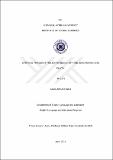Please use this identifier to cite or link to this item:
http://hdl.handle.net/11547/1402Full metadata record
| DC Field | Value | Language |
|---|---|---|
| dc.contributor.author | Abbasoğlu, Asena | - |
| dc.date.accessioned | 2019-04-17T11:40:07Z | - |
| dc.date.available | 2019-04-17T11:40:07Z | - |
| dc.date.issued | 2018-06 | - |
| dc.identifier.uri | http://hdl.handle.net/11547/1402 | - |
| dc.description.abstract | Sylvia Plath ve Ingeborg Bachmann kadının sosyal düzendeki yeri üzerine çalışan, kadın ruhundaki kendini yok etme ve intihar eyilimlerine ışık tutmak amacıyla ilişkilerin özelliklerini inceleyen, aynı etnik kökene sahip önde gelen çağdaş savaş sonrası yazarlardır. Eserlerinde, ruh hallerini, acılarını ve duygu ve davranışlarının doğurduğu sonuçları yansıtarak psikanalitik bir bakış açısı sergilerler. Bu çalışmada benzer psikolojik problemleri yaşamış ve elektroşok terapisi gibi benzer tedavileri deneyimlemiş bireyler olarak kendilerine zarar veren davranışlarının nedenleri çeşitli psikolojik teoriler aracılığıyla incelenecektir. Malinadaki ‘anima-animus’ teorisine yapılan doğrudan gönderme dikkate alınarak ve Ich’in rüya döngüleri ile Esther’in bilinçakışı tekniği bağdaştırılarak, Freud ve Jung’un ruhun yapısı üzerine yaptığı araştırmalar ışığında Malina ve The Bell Jar eserleri yorumlanacaktır. Ayrıca, bu romanların sosyolojik boyutları Emile Durkheim’ın intiharla ilgili teorilerinden yola çıkarak ‘entegrasyon’ ve ‘yabancılaşma’ çerçevesinde ele alınması yoluyla tartışılacaktır. Bu çalışma faşizan yaklaşımlar sonucunda kendine zarar verme ve kadın intiharı konusunda detaylı bir inceleme yapacaktır. İntiharın ortak sebeplerini ortaya çıkarmak için Sylvia Plath’ın The Bell Jar ve Ingeborg Bachmann’ın Malina romanlarındaki kadın kahramanların kişilik özellikleri ve kimlikleri incelenerek kendine zarar verme işlemi bu iki romanda karşılaştırılacaktır. Bachmann ve Plath’ın romandaki yansımalarından da yararlanarak Malina ve The Bell Jar’ı yorumlamak için kahramanları intihara iten olaylar ve yan karakterler de incelenip analiz edilecektir. Bu çalışma ayrıca faşizan ve bunaltıcı norm ve kuralların kadınları kısıtlayan ve onların özgünlüklerini ve bireyselleşmelerini engelleyen psikolojik boyutlarıyla ilgilenmektedir. Arıca bu çalışma mitlerin nasıl bir işlev gördüğünü, neyi başarmayı amaçladıklarını sosyolojik açıdan irdeleyecektir. | tr_TR |
| dc.language.iso | en | tr_TR |
| dc.subject | Faşizm | tr_TR |
| dc.subject | İlişkiler | tr_TR |
| dc.subject | Psikoanaliz | tr_TR |
| dc.subject | Anima-animus | tr_TR |
| dc.subject | Boyunduruk | tr_TR |
| dc.subject | Kimlik | tr_TR |
| dc.subject | Özgünlük | tr_TR |
| dc.subject | Fascism | tr_TR |
| dc.subject | Relationships | tr_TR |
| dc.subject | Psychoanalysis | tr_TR |
| dc.subject | Anima-animus | tr_TR |
| dc.subject | Oppression | tr_TR |
| dc.subject | İdentity | tr_TR |
| dc.subject | Authenticity | tr_TR |
| dc.title | WRITING THROUGH THE EXPERIENCE OF FIRE: BACHMANN AND PLATH | tr_TR |
| dc.type | Thesis | tr_TR |
| dc.description.abstractol | Sylvia Plath and Ingeborg Bachmann were two outstanding contemporary post-war writers of the same ethnicity, dealing with the place of women in the social order and examining the characteristics of relationships in order to shed light on the selfdestructive and suicidal inclinations in the female psyche. In their works, they provide a psychoanalytic perspective by presenting their mental state, sufferings, and the consequences of their emotions and actions. Suffering similar psychological problems and having experienced alike treatments like the electro-shock therapy, the stimuli for their self-destructive behaviors will be analyzed through various psychological theories. Considering the direct reference to the ‘anima-animus theory’ in Malina and associating Ich’s dream cycles with Esther’s employment of ‘stream of consciousness’, Jung and Freud’s researches on the structure of the psyche will be a fundamental medium to interpret Malina and The Bell Jar. The sociological dimensions of these novels will also be discussed through Emile Durkheim’s theories on suicide within the framework of ‘integration’ and ‘alienation’. This work will make an intensive study of self-destruction and the suicide of women as a consequence of fascist behaviors. It will compare the process of self-destruction in two works of literature, Ingeborg Bachmann’s Malina and Sylvia Plath’s The Bell Jar, examining the female protagonists’ personality traits and their identities to reveal common motives for suicide. It will also examine and analyze events and secondary characters leading the narrator protagonists to suicide, using the reflections of Bachmann and Plath to interpret The Bell Jar and Malina. It will concern itself with the psychological dimensions of norms and regulations that function in a fascistic and depressive way, limiting females and depriving them of authenticity and individuation. This study will also attempt to explore the purpose of myths from a sociological perspective, to display how they function and what they intend to accomplish. | tr_TR |
| Appears in Collections: | Tezler -- Thesis | |
Files in This Item:
| File | Description | Size | Format | |
|---|---|---|---|---|
| WRITING THROUGH THE EXPERIENCE OF FIRE BACHMANN AND.pdf | Yüksek Lisans Tez Dosyası | 760.58 kB | Adobe PDF |  View/Open |
Items in DSpace are protected by copyright, with all rights reserved, unless otherwise indicated.
